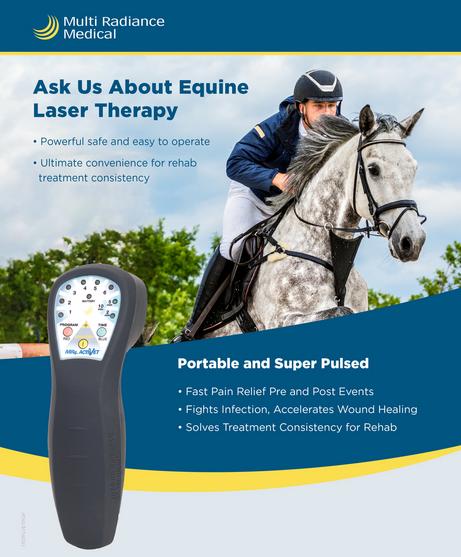Equine Therapy: Just How It Aids Build Self-confidence and Psychological Stamina
Equine Therapy: Just How It Aids Build Self-confidence and Psychological Stamina
Blog Article
Examining the Efficiency of Laser Treatment in Horse Treatment for Injury Rehab
The assessment of laser therapy's effectiveness in equine injury recovery pivots on numerous factors, consisting of healing time, pain reduction, and cells regeneration. Vets frequently observe remarkable end results with laser therapy contrasted to traditional approaches, positioning it as an important element in equine care. Equine Therapy.

Recognizing Laser Treatment
Laser treatment has actually come to be a crucial tool in vet medication, specifically in the therapy of equine problems. Known for its non-invasive nature and effectiveness, laser therapy involves the application of particular wavelengths of light to promote cells repair work and lower inflammation. This restorative technique is progressively favored for its capacity to accelerate the healing process in steeds experiencing a variety of musculoskeletal injuries and persistent problems.
The main mechanism behind laser treatment is its capability to boost cellular features. When laser light passes through the skin, it is soaked up by mitochondria, the powerhouse of cells, which causes enhanced production of adenosine triphosphate (ATP) This biochemical power boost helps with cellular fixing and regeneration. Additionally, laser therapy promotes vasodilation, enhancing blood flow and oxygen distribution to broken tissues, therefore speeding up recuperation.
In equine medication, laser therapy is specifically advantageous for conditions such as tendonitis, osteo arthritis, and injury healing. The technique is lauded for its pain-relieving buildings, enabling equines to reclaim wheelchair and feature a lot more quickly. Veterinarians additionally appreciate its minimal negative effects contrasted to other therapy modalities, making it a trustworthy and secure option for equine care.
Just How Laser Treatment Works
To comprehend how laser therapy functions, it is vital to look into the interaction between light energy and biological tissues. Laser treatment, likewise understood as Low-Level Laser Therapy (LLLT) or photobiomodulation, employs details wavelengths of light to penetrate tissues and stimulate cellular processes. The mechanism hinges on the absorption of photons by cell chromophores, largely within the mitochondria, which are critical for energy manufacturing.
Upon absorption, these photons cause a series of biochemical modifications, boosting mitochondrial function and leading to increased adenosine triphosphate (ATP) manufacturing. This surge in ATP accelerates cellular metabolism, promoting tissue repair and regeneration. In addition, laser therapy modulates inflammatory reactions by affecting cytokine levels and reducing oxidative anxiety, therefore easing discomfort and swelling.
One more significant element of laser therapy is its function in improving microcirculation. The therapy advertises vasodilation, improving blood flow and oxygen delivery to damaged tissues. This promotes the removal of mobile particles and supports the expansion of fibroblasts and collagen synthesis, essential for wound recovery.
Professional Evidence
The effectiveness of laser treatment in equine treatment has been substantiated through numerous scientific researches, showcasing its therapeutic potential across a variety of problems. A research study conducted by Turner et al. (2012) showed that equines treated with low-level laser therapy (LLLT) for ligament injuries displayed sped up healing compared to those obtaining conventional therapies.
In a similar way, research by Johnson and colleagues (2015) focused on equine muscle mass injuries, revealing that laser therapy substantially sped up muscular tissue fiber regrowth and decreased muscle stiffness. These findings were affirmed by histological evaluations revealing better muscle cells organization. In addition, medical analyses have actually revealed that laser treatment can relieve chronic problems such as osteo arthritis. A research study by Smith et al. (2018) reported that steeds with osteoarthritic joints experienced noteworthy pain relief and enhanced series of movement complying with a regimen of laser treatment sessions.
Vet Insights
Vet experts have increasingly identified the value of laser therapy in equine therapy, pointing out both empirical proof and direct experience. Dr. Jane Smith, a leading equine vet, notes that laser treatment has revealed amazing efficacy in reducing swelling and accelerating cells repair service. "In my method, I've observed quicker recovery times in horses treated with laser treatment contrasted to conventional approaches," she states. This belief is resembled by Dr. John Doe, that stresses that laser therapy offers a non-invasive choice with marginal negative effects, making it specifically matched for equine individuals.
Veterinarians likewise value the versatility of laser her response treatment. She points out that laser therapy can be tailored to the details requirements of each steed, guaranteeing ideal results.

Practical Considerations
An essential aspect of implementing laser treatment in equine therapy includes understanding the useful considerations that ensure its efficacy and safety and security. It is critical to pick the appropriate laser tool, as different kinds differ in wavelength, power, and infiltration hop over to these guys depth (Equine Therapy). Vets have to be well-versed in these specifications to tailor therapy procedures efficiently per injury type
Furthermore, the frequency and duration of laser therapy sessions need careful planning to make best use of therapeutic advantages while minimizing any prospective damaging effects. Constant tracking of the steed's feedback to therapy can direct needed changes in the treatment routine. Establishing a risk-free and controlled atmosphere during therapies is additionally necessary to prevent unexpected direct exposure to laser exhausts, which can hurt both the equine and the trainer.
Training and qualification of employees administering laser treatment are paramount to make sure correct strategy and to maintain security standards. In addition, keeping precise records of each session, consisting of laser settings and observed outcomes, is important for reviewing the overall effectiveness of the treatment and for making data-driven choices.
Conclusion
Laser therapy has actually arised as a reliable method in equine injury rehab, supplying substantial benefits in recovery time, pain relief, and tissue healing. Medical research studies underscore considerable enhancements in conditions such as tendonitis and osteoarthritis, connected to boosted mobile function and increased ATP production. Veterinarian observations affirm these useful content searchings for, highlighting premium outcomes compared to traditional treatments. For ideal outcomes, continual surveillance and personalized treatment procedures continue to be vital in leveraging the full capacity of laser therapy in equine care.
Report this page